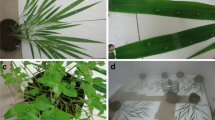Abstract
The effect of microclimate variables on development ofClonostachys rosea and biocontrol ofBotrytis cinerea was investigated on rose leaves and crop residues. C.rosea established and sporulated abundantly on inoculated leaflets incubated for 7–35 days at 10°, 20° and 30°C and then placed on paraquat—chloramphenical agar (PCA) for 15 days at 20°C. On leaflets kept at 10°C, the sporulation after incubation on PCA increased from 60% to 93% on samples taken 7 to 21 days after inoculation, but decreased to 45% on material sampled after 35 days. A similar pattern was observed on leaves incubated at either 20° or 30°C. The sporulation ofC. rosea on leaf disks on PCA was not affected when the onset of high humidity occurred 0, 4, 8, 12 or 16 h after inoculation. However, sporulation was reduced to 54–58% on leaflets kept for 20–24 h under dry conditions after inoculation and before being placed on PCA. The fungus sporulated on 68–74% of the surface of leaf disks kept for up to 24 h at high humidity after inoculation, but decreased to 40–51% if the high humidity period before transferral to PCA was prolonged to 36–48 h. The growth ofC. rosea on leaflets was reduced at low inoculum concentrations (103 and 104 conidia/ml) because of competition with indigenous microorganisms, but at higher concentrations (105 and 106 conidia/ml) the indigenous fungi were inhibited. Regardless of the time of application ofC. rosea in relation toB. cinerea, the pathogen’s sporulation was reduced by more than 99%. The antagonist was able to parasitize hyphae and conidiophores ofB. cinerea in the leaf residues. AsC. rosea exhibited flexibility in association with rose leaves under a wide range of microclimatic conditions, and in reducingB. cinerea sporulation on rose leaves and residues, it can be expected to suppress the pathogen effectively in rose production systems.
Similar content being viewed by others
References
Elad, Y. (1988) Latent infection ofBotrytis cinerea in rose flowers and combined chemical and physiological control of the disease.Crop Prot. 7:361–366.
Elad, Y. and Evensen, K. (1995) Physiological aspects of resistance toBotrytis cinerea.Phytopathology 85:637–643.
Elad, Y, Kirshner, B. and Gotlib, Y. (1993) Attempts to controlBotrytis cinerea on roses by pre-and postharvest treatments with biological and chemical agents.Crop Prot. 12:69–73.
Elad, Y. and Shtienberg, D. (1995)Botrytis cinerea in greenhouse vegetables: chemical, cultural, and physiological and biological controls and their integration.Integ. Manage. Rev. 1:15–29.
Elad, Y. and Volpin, H. (1991) Heat treatment for the control of rose and carnation grey mould(Botrytis cinerea).Plant Pathol. 40:278–286.
Hammer, P.E. and Marois. J.J. (1989) Nonchemical methods for post-harvest control ofBotrytis cinerea on cut roses.J. Amer. Soc: Hortic. Sci. 114:100–106.
Hausbeck, M.K. and Moorman, G.W. (1996) ManagingBotrxtis in greenhouse-grown flower crops.Plant Dis. 80:1212–1219.
Horst, R.K. (1983) Compendium of Rose Diseases. APS Press, St. Paul, MN, USA.
Jarvis, W.R. (1992) Managing Diseases in Greenhouse Crops. APS Press, St. Paul. MN. USA.
Köhl, J. and Fokkema, N.J. (1994) Fungal interactions on living and necrotic leaves.in: Blakeman. J.P. and Williamson. B. [Eds.] Ecology of Plant Pathogens. CABI, Oxon, UK. pp. 321–324.
Köhl, J. and Fokkema, N.J. (1998) Strategies for biological control of necrotrophic fungal pathogens.in: Boland, G.J. and Kuykendall, L.D. [Eds.] Plant-Microbe Interactions and Biological Control. M. Dekker Inc., New York. NY. pp. 49–88
Köhl, J., Mollhoek. W.M.L., van der Plas, C.H. and Fokkema, N.J. (1995) Suppression of sporulation ofBotrytis spp. as a valid biocontrol strategy.Eur. J. Plant Pathol. 101:251–259.
Köhl, J. Mollhoek, W.M.L., van der Plas, C.H. and Fokkema, N.J. (1995) Effect ofUlocladium atrum and other antagonists on sporulation ofBotrytis cinerea on dead lily leaves exposed to field conditions.Phytopathology 85:393–401.
Morandi, M.A.B., Sutton, J.C. and Maffia, L.A. (2000) Relationships of aphid and mite infestations to controlof Botrytis cinerea byClonostachys rosea in rose(Rosa hybrida) leaves.Phytoparasitiea 28:55–64.
Morandi, M.A.B., Sutton, J.C. and Maffia, L.A. (2000) Effects of host and microbial factors on development ofClonostaehys rosea and control ofBotrytis cinerea in rose.Eur. J. Plant Pathol. 106:439–448.
Peng, G. and Sutton, J.C. (1991) Evaluation of microorganisms for biocontrol ofBotrytis einerea in strawberry.Can. J. Plant Pathol. 13:247–257.
Redmond, J.C, Marois, J.J. and MacDonald, J.D. (1987) Biological control ofBotrytis einerea on roses with epiphytic microorganisms.Plant Dis. 71:799–802.
Schroers, H.J., Samuels, G.J., Seifert, K.A. and Gams, W. (1999) Classification of the mycoparasiteGliocladium roseum inClonostachys asC. rosea, its relationship toBionectria ochroleuca. and notes on other Gliocladium-like fungi.Mycologia 91:365–385.
Snedecor, G.W. and Cochran, W.G. (1989) Statistical Methods. 8th ed. The lowa State University Press, Ames, IA, USA.
Sutton, J.C. (1995) Evaluation of microorganisms for biocontrol: ¡i¿Botrytis cinerea ¡/i¿and strawberry, a case study.in. Andrews, J.H. and Tommerup, I.C. [Eds.] Advances in Plant Pathology. Vol. II, pp. 173–190. Academic Press, London, UK.
Sutton, J.C., Li, D.-W., Peng, C., Yu, H., Zhang, P. and Valdebenito-Sanhueza, RM. (1997)Gliocladium roseum. a versatile adversary ofBotrytis einerea in crops.Plant Dis. 81:316–328.
Sutton, J.C. and Peng, G. (1993) Biocontrolof Botrytis cinerea in strawberry leaves.Phytopathology 83:615–621.
Tatagiba, J. da S., Maffia, LA., Barreto, R.W., Alfenas, A.C. and Sutton, J.C. (1998) Biological control ofBotrytis cinerea in residues and flowers of rose(Rosa hybrida).Phytoparasitica 26:8–19.
Yu, H. and Sutton, J.C. (1994) Inoculum concentration ofBotrytis cinerea and of the biocontrol agentGlioeladium roseum in relation to suppression of the pathogen in raspberry.Phytopathology 84:1377 (abstr.).
Yu, H. and Sutton, J.C. (1997) Morphological development and interactions ofGlioeladium roseum andBotrytis cinerea in raspberry.Can. J. Plant Pathol. 19:237–246.
Yu, H. and Sutton, J.C. (1998) Effects of inoculum density, wetness duration, and temperature on control ofBotrytis cinerea byGlioeladium roseum in raspberry.Can. J. Plant Pathol. 20:243–252.
Author information
Authors and Affiliations
Corresponding author
Rights and permissions
About this article
Cite this article
Morandi, M.A.B., Maffia, L.A. & Sutton, J.C. Development ofClonostachys rosea and interactions withBotrytis cinerea in rose leaves and residues. Phytoparasitica 29, 103–113 (2001). https://doi.org/10.1007/BF02983954
Received:
Revised:
Issue Date:
DOI: https://doi.org/10.1007/BF02983954




